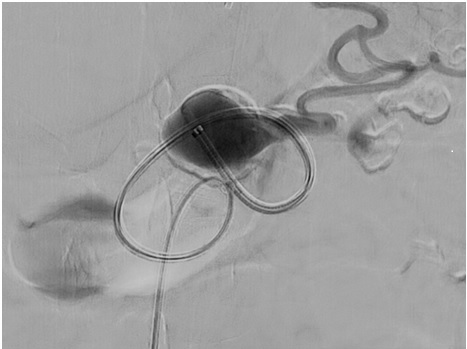Back to 2016 Annual Symposium ePosters
Robotically-Assisted Treatment of a Splenic Artery Aneurysm
Chris Paprzycki, MD, Sophie Afridi, MD, Brian Kuhn, MD, Patrick Muck, MD.
TriHealth - Good Samaritan Hospital, Cincinnati, OH, USA.
OBJECTIVES:
Endovascular treatment is a widely accepted first-line therapy for splenic artery aneurysms. However, treatment can frequently be difficult due to the tortuosity of the splenic artery. The Magellan Robotic System remotely enables precise steering of guidewires through complex anatomy by allowing intravascular catheter shaping to any desired bend or curve. We present a case using robotic assistance in the treatment of a splenic artery aneurysm.
METHODS:
A 72 year old multiparous female was incidentally found to have a splenic artery aneurysm during preoperative evaluation for mitral valve replacement. A computed tomography (CT) scan of her abdomen demonstrated the presence of a 2.3-cm saccular aneurysm in the mid-portion of a very tortuous splenic artery. Considering her challenging anatomical features, an endovascular approach using the assistance of robotically steerable catheters was planned.
Utilizing the Magellan Robotic System from a remote workstation, the leading catheter was carefully steered through the splenic artery into the aneurysm (Figure 1). The distal splenic artery could not be accessed due to the significant tortuosity. Coil embolization was performed within the aneurysm sac using a packing technique with seven 14-mm Nester coils. A single 7-3 mm tapering diameter Tornado coil was placed in the proximal splenic artery to occlude in-flow into the aneurysm.
RESULTS:
A completion angiogram demonstrated successful thrombosis of the splenic artery aneurysm with continued perfusion of the spleen via collaterals. Total fluoroscopy time was 27.5 minutes. There was no evidence of perforation or dissection, and the patient was discharged home the same day. A follow-up CT scan demonstrated continued thrombosis of the splenic aneurysm without evidence of splenic infarction.
CONCLUSIONS:
Coil embolization is a valuable first-line therapy for saccular splenic artery aneurysms. However, the splenic artery often can be challenging to traverse with standard transcatheter techniques, and may be associated with higher radiation exposure to the operator. The Magellan Robotic System offers improved maneuverability and stability, and can be an effective tool for remotely delivering transcatheter therapy through challenging anatomy.

Figure 1. Splenic artery aneurysm angiogram in the anterior-posterior plane.
Back to 2016 Annual Symposium ePosters
|







